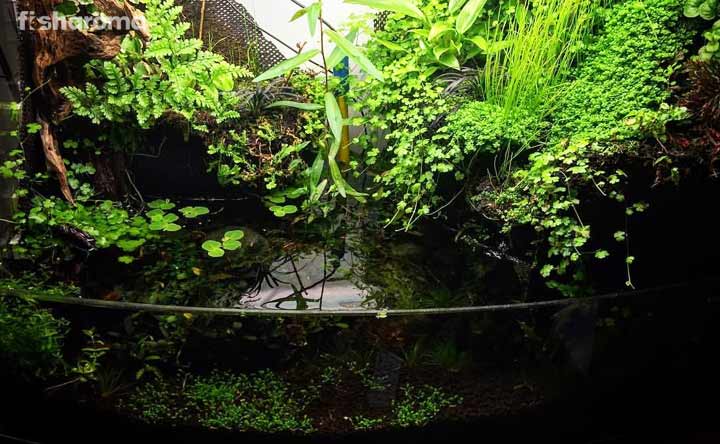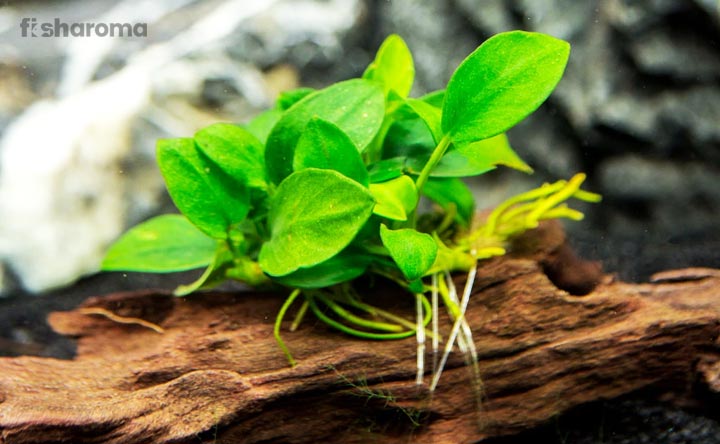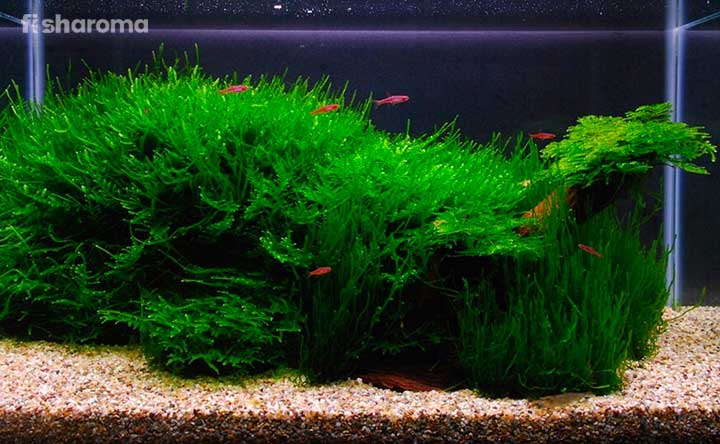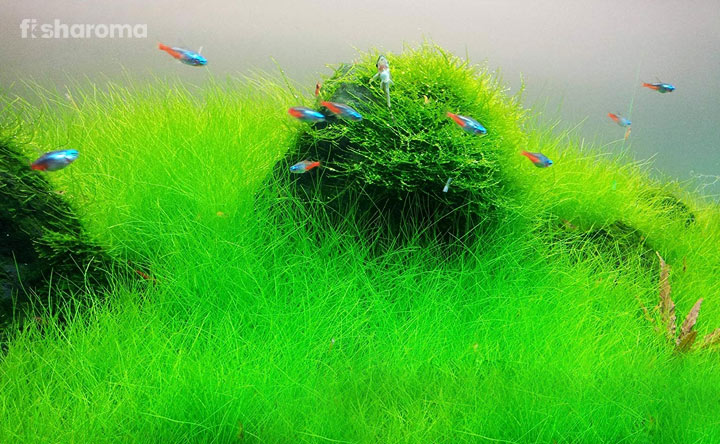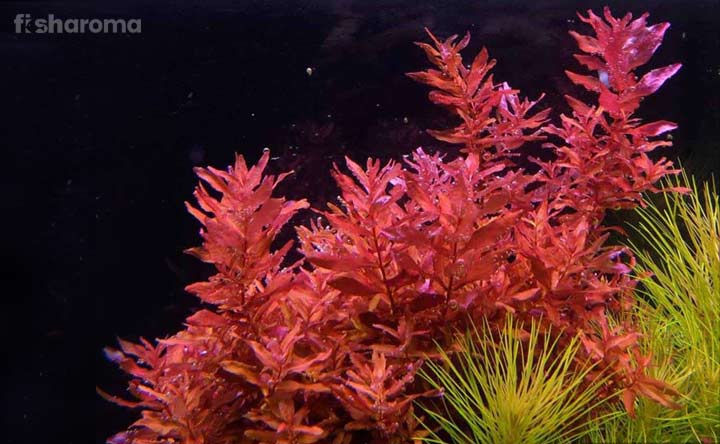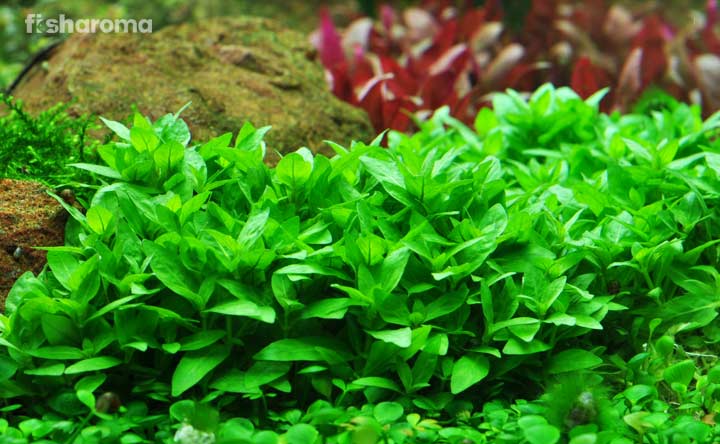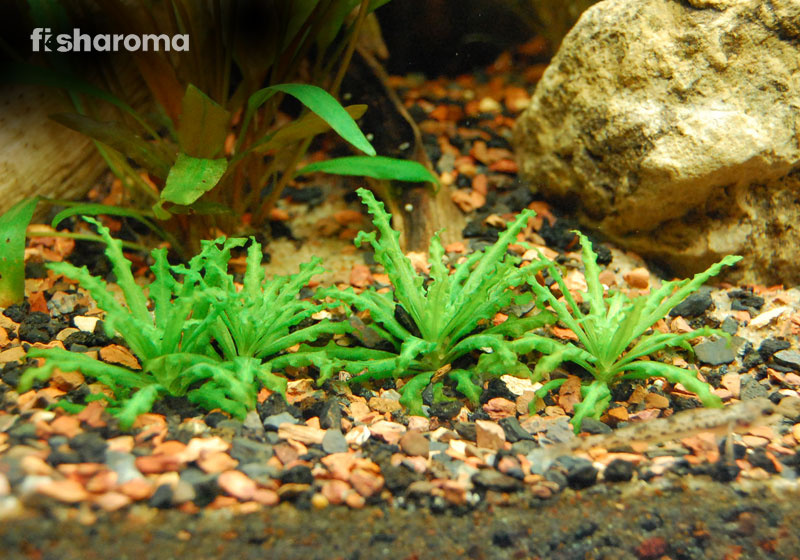15 Best Aquarium Plants for Beginners (Ultimate Guide)

- Water Wisteria
- Java Fern
- Dwarf Hairgrass
- Java Moss
- Dwarf Aquarium Lily
- Amazon Sword Plant
- Duckweed
- Chain Sword
- Beckett’s Water Trumpet
- Aponogeton ulvaceus
- African Water Fern
- Cryptocoryne wendtii
- Dwarf Baby Tears
- Dwarf Water Clover
- Anacharis
- Care Guide for Aquarium Plants
- Benefits of Aquarium Plants
- Summary
Life is incomplete without the right ecological balance of flora and fauna. Just like on land, the presence of vegetation is of utmost importance for the sea animals. Therefore, when you host a water creature in your home, it is necessary to replicate its natural habitat as much as possible. And a big part of it is the presence of flora, as in, plants. But how do you decide which aquarium plant to keep and which one to not? Which one is easy to maintain and which one would keep you on your toes? Well, we breakdown everything related to aquarium plants so that you now can have a healthy environment in your tank with their inclusion.
Overview
Adding fish and other creatures is nice and good, but if you want to create a wholesome environment, plantation of your tank is a must. From adding to the aesthetics to creating a natural habitat for the animals residing in it, from helping fish in their breeding to serving as their food source, aquarium plants have a multi-faceted usage.
Although raising plants in an aquarium is not rocket science, you still need to know a thing or two about them before bringing them to your home. Having a knowledge of which plant is suitable for you as a beginner and the requirements of some of the most popular aquarium plants will position you better as an aquarist.
Best Aquarium Plants for a Beginner
If you are a beginner and don’t have a lot of experience with aquarium plants, then these following options might be viable for you. Take a look.
Water Wisteria

| Scientific Name | Hygrophila difformis |
| Temperature | 70-82° F (21-27° C) |
| Lighting | Moderate to High |
| Growth Rate | Fast |
| Placement | Rooted in the substrate or floated on the surface |
Having tall lace-like green leaves that act as perfect hiding spots for the species living inside along with providing shelter for them, Water Wisterias are a great addition to your tank. They are also known as “Bunch plants”. Sandy substrate is ideal for them if you want to root them to the ground. Else, you are free to keep them floated on the surface too.
The leaves of this aquatic plant are fascinating to watch, especially when they move against the water current. They are extremely easy to propagate. Along with the aforementioned temperature, try to keep the pH level of the water between 6.5-7.5 and the carbonate hardness between 2-8 dKH. Ideal tankmates for this plant include Betta, Rasbora, Dwarf Gourami, Corydoras Catfish, Guppy, Danio, among others.
Java Fern

| Scientific Name | Microsorum pteropus |
| Temperature | 68-82° F (20-27° C) |
| Lighting | Low to Moderate |
| Growth Rate | Medium |
| Placement | Mid to background |
Native to Southeast Asia, Java Fern is composed of two primary components – leaves and rhizome. The rhizomes are hair-like strings that are brown in color that attach themselves to various surfaces. The leaves of this plant are large and hardy and come in various shades of green, from medium to dark.
The pH level of the water should be 6-7 while the general hardness should be 3-8 dGH. They function well in a bare bottom tank since they don’t require any substrate. Coming to their plantation, you need to attach them to driftwood or rocks instead of burying them to the substrate.
Java Ferns consume nutrients from the water, which is why they don’t require additional fertilizers. They are compatible with a wide variety of fish including Catfish, Cichlid, Arowana, Tiger Oscar, among others.
Dwarf Hairgrass

| Scientific Name | Eleocharis parvula |
| Temperature | 50-85° F (10-29° C) |
| Lighting | Moderate |
| Growth Rate | Fast |
| Placement | Carpet |
One of the most popular choices when it comes to carpeting your aquarium, Dwarf Hairgrass are spread all over the world, from North America to Asia and Europe to South America. Apart from providing shelter to bottom-dwelling species, this plant also helps in oxygenating the tank. Besides, it also helps in controlling the level of nitrate in the water.
Evident by their name, they have a grass-like appearance in the form of blades and strands, with each strand being extremely thin, just like a hair. The pH level of the water should be 6.5-7.5 along with a carbonate hardness of 2-10 dKH.
Dwarf Hairgrass are a great choice for bottom-dwelling fish, since they act as their additional shelter. Species like Yoyo Loach, Clown Loach, Corydoras Catfish, Zebra Loach, and Bumblebee Catfish, along with Guppy, Molly, Tetra and Danio are suitable tankmates for this aquarium plant.
Java Moss

| Scientific Name | Vesicularia dubyana |
| Temperature | 59-82° F (15-28° C) |
| Lighting | Low |
| Growth Rate | Slow to medium |
| Placement | Mid and foreground |
With small overlapping oval-shaped leaves and small inconsistent branched stems, Java Moss doesn’t have roots and instead absorb nutrients through its leaves. They can float freely on the surface or their rhizoids can be attached to driftwood, rocks or other decorative items in the tank.
When used as a floating plant, they act as a great spawning site for your fish. The pH level of the water that houses Javas Moss should be 5.5-8.0 while the general hardness should be 6-20 dGH. Native to Southeast Asia, this plant is ideal for being used as a foreground cover for a rocky or sandy substrate.
Remember, this is mostly a slow grower, especially when compared to their contemporaries in this list. For propagating this plant, you simply need to divide pieces off the main plant and put them in a different location.
Dwarf Aquarium Lily

| Scientific Name | Nymphaea leibergii |
| Temperature | 72-82° F (22-28° C) |
| Lighting | Moderate to High |
| Growth Rate | Medium |
| Placement | Foreground to midground |
One of the most distinctive aquarium plants out there, Dwarf Aquarium Lily are native to India and have triangular leaves that come in green, pink and red colors. When kept in shallow water, they even have the potential to flower.
The pH level of the water should be 5.5-7.5 while the general hardness should be 2-12. Apart from beautifying your aquarium, they also provide a vegetative refuge to various aquarium species, especially fries, Nano Fish and Dwarf Shrimps.
While planting a Dwarf Aquarium Lily, remember not to bury the entire bulb base into the substrate, else it will rot. Don’t panic when they will shed leave for a continuous period, since they occasionally go through a dormant period, after which they grow new leaves.
Amazon Sword Plant

| Scientific Name | Echinodorus grisebachii |
| Temperature | 60-82° F (15-27° C) |
| Lighting | Mild |
| Growth Rate | Medium |
| Placement | Midground |
Native to the Amazon River basin, Amazon Sword Plants can adapt to a wide variety of temperature, and have a short stem along with a bushy appearance. In fact, they derive their name from their uniquely-shaped leaves that resemble the blades of a sword. This means that the leaves are widest near their base and they narrow down at their tip.
Usually dark green in color, the rhizomes of this aquarium plant are pretty strong that penetrate deep into the substrate. The pH level of the water should be 6.5-7.5 while the general hardness should be 8-12 dGH.
Suitable tankmates for this plant include Gourami, Guppy, Molly, Platy, Zebra Danio, Angelfish, and Danio, among others. Try and avoid keeping them with Goldfish since they are known to uproot this plant.
Duckweed

| Scientific Name | Lemnoideae |
| Temperature | 42-91° F (5-32° C) |
| Lighting | High |
| Growth Rate | High |
| Placement | Floating |
Oval in structure, Duckweeds contain two air pockets that allow them to float on the water surface. Light, bright green in color, they are one of the smallest flowering water plants. Mostly seen in ponds and wetlands, they thrive in low- current water.
Duckweeds are natural water purifiers that help in treating contaminated water by absorbing excess phosphates and nitrogen from it. They prefer direct, bright lighting and the pH level of the water should be 5-9.
Creating a mesmerizing visual spectacle on the water, they are a treat to watch. However, don’t cover the entire surface of your tank with this plant since that may lead to oxygen deprivation.
Chain Sword

| Scientific Name | Helanthium tenellum |
| Temperature | 68-84° F (20-28° C) |
| Lighting | Moderate |
| Growth Rate | Moderate |
| Placement | Foreground |
With a thin, erect and sometimes curved stem, Chain Swords have linear leaves. They are also known as Narrow Leaf plant and are famous for forming a thick carpet with their innumerable runners.
The PH level of the water should be 6.2-7.5 while the carbonate hardness should be 3-8 dKH. You have to use sandy solid substrate for this plant and make sure they have access to plenty of light.
Amphibious by nature, they will grow both fully and partially submerged. In order to propagate this aquatic plant, you need to cut the roots apart of the baby plant so that they grow separate from each other. You may only do so when the baby plant is half the size of the parent plant.
Beckett’s Water Trumpet

| Scientific Name | Cryptocoryne beckettii |
| Temperature | 73-83° F (23-28° C) |
| Lighting | Low to moderate |
| Growth Rate | Slow |
| Placement | Foreground to midground; background in small tanks |
Native to Asia, Beckett’s Water Trumpet requires a large tank since they grow to a substantial size. Being the hardy plant that they are, they can adapt to a wide range of parameters. When grown above the waterline, they can produce tube-shaped flowers.
The pH level of the water should be 5.5-8 while the lighting should be kept mostly low. They are known for their bright green large leaves that serve as a foreground and/or midground aquatic plant.
Do not move this plant constantly because they need their time to settle in; and once they do, you don’t have to put much effort into taking care of them, including in their propagation, which they will do simply through runners that grow into new plants.
Aponogeton ulvaceus

| Scientific Name | Aponogeton ulvaceus |
| Temperature | 71-84° F (22-28° C) |
| Lighting | Moderate |
| Growth Rate | Fast |
| Placement | Background plant |
Known for producing rippled leaves, Aponogeton ulvaceus have a small cone-shaped rhizome. They are native to Madagascar and grow both in low and moderate current water.
The pH level of the water should be 6.5-7.5 and additional carbon-dioxide supplements would accelerate their growth. They must be planted deep into the substrate so that they don’t get uprooted by the species living inside.
An interesting feature of this aquarium plant is that they fare well when the aquarium is heavily stocked since they get access to more waste products. However, try to avoid keeping them with snails since they can do a lot of damage to this splendid aquatic plant of yours.
African Water Fern

| Scientific Name | Bolbitis heudelotii |
| Temperature | 74-84° F (23-28° C) |
| Lighting | High |
| Growth Rate | Slow |
| Placement | Foreground and background |
Evident by their name, the African Water Ferns are native to Africa, specifically in the Congo River basin. Extremely slow in their growth rate, they grow a single leaf every two months. The dark green leaves of this plant produce a great contrast when kept with colorful fish.
The pH level of the water where you house this plant must be 6.0-8.5 while the general hardness should be 5-15 dGH. Instead of planting them on the substrate, you need to attach them to a porous rock or driftwood. Despite being very fragile, they are pretty easy to maintain. All you need to provide is a nutrient-rich substrate and fertilizers on a weekly basis unless your tank is heavily stocked with fish that produces ample waste regularly.
Try to keep them with Otocinclus Catfish and Shrimps instead of Koi, Silver Dollar, Barb or Goldfish who are likely to eat them.
Cryptocoryne wendtii

| Scientific Name | Cryptocoryne wendtii |
| Temperature | 68-83°F (20-28° C) |
| Lighting | Low |
| Growth Rate | Medium |
| Placement | Midground and background |
Coming in a wide variety of colors (brown, red, green) and shape of leaves (small, medium, large). The Cryptocoryne wendtii are native to Sri Lanka and grow abundantly in shaded areas where they have less access to direct light. The ideal pH level of the water for this plant should be 6.0-7.5.
Very low-maintenance by nature, you don’t have to put a lot of effort into taking care of them. The only thing that you need to be patient about is that they are relatively slow in their growth rate.
Propagation is also very easy in this plant. You just need to remove a small portion of their root that has a stem attached to it and plant it in the substrate. Mature plants can also be pulled apart to create new plants, although it should be done delicately and gently.
Dwarf Baby Tears

| Scientific Name | Hemianthus callitrichoides |
| Temperature | 68-82° F (20-27° C) |
| Lighting | High |
| Growth Rate | Medium |
| Placement | Foreground |
Ideal for breeding tanks, Dwarf Baby Tears are known for producing clusters of small leaves, forming a thick carpet in your aquarium. Native to Cuba, they can be rooted in driftwood for aquaspacing. The pH level of the water should be 5.0-7.5. Strong, bright light must be provided to them, otherwise, they will rise up to the water surface.
You can plant a whole pot (as they are sold in the market) in the substrate in one place and wait for them to grow on their own, or you can also do the tedious process of separating the small stems and planting them an inch apart for thick and fast coverage.
An iron-rich substrate must be provided to them along with carbon-dioxide supplementation and constant fertilization. The dense carpet of this plant acts as an apt place for fish to lay their eggs. Do not keep this plant with plant-nipping fish such as Jack Dempsey, Goldfish, or Oscar.
Dwarf Water Clover

| Scientific Name | Marsilea minuta |
| Temperature | 73-78° F (23-25° C) |
| Lighting | Moderate |
| Growth Rate | Fast |
| Placement | Foreground |
Used extensively for aquaspacing, Dwarf Water Clovers are also known as Airy Pepperwort. Having light brown and greenish rhizome, the leaves of this plant emerge from the water instead of floating on it. The clover-shaped leaves of this species make them one of the most popular aquatic plants worldwide.
The ideal pH level of the water for this plant should be 6.5-7.5 while the general hardness of the water should be around 5-12 dGH. Extremely versatile in nature, they are tolerant of most environments. The beauty of this plant is accentuated when kept with a dark substrate. This plant spreads by runners, seeds, shoots, and spores. The color and texture added by this plant to an aquarium gives the vibe of a water garden.
Anacharis

| Scientific Name | Elodea |
| Temperature | 60-82° F (15-27° C) |
| Lighting | Moderate |
| Growth Rate | Fast |
| Placement | Background |
Apart from being visually appealing, Anacharis act as a water purifier, food source and shelter provider to various fish. They are also known as Brazilian Waterweed and Egeria, among others. They have a long green stem that has small green leaves covering the entirety of it. The stems are shaped in the form of tubes that have nodes, from which the leaves grow, with each node having a whorl of 3-6 leaves. In summer, they are known to produce a three-petal white flower.
Coming to their water requirement, the pH level should be 6.5-7.5 while the carbonate hardness should be 3-8 dKH. Apart from serving as hiding and egg-laying spots for aquatic species, Anacharis also serves as a dietary source for many animals such as Goldfish, Cichlid and Apple Snails.
Propagation is also extremely easy and all you have to do here is to choose a healthy stem that is at least 8” (20 cm) long and bury it 1-2” (3-5 cm) into the substrate. Don’t forget to trim the leaves from the stem before planting it, else it will rot.
Care Guide for Aquarium Plants
Caring for your aquatic plants would involve looking into these following sectors.
Water Condition
Similar to fish, the type of water that you select for your plant varies from species to species. Therefore, you must make sure the temperature, pH level, and hardness of the water meet the requirements of your aquarium plant.
Substrate
This is in relation to the plants that have to be rooted in your aquarium. Since the substrate serves as their main source of nutrient, you must have a thorough knowledge of what kind of substrate your aquarium plant needs.
Lighting
The growth of each aquarium plant is dependent on the accessibility of light, or the lack of it. Some thrive in bright light, while others perish in it. Therefore, the need for providing the exact intensity of light is important.
Fertilizers
Fertilizers, along with supplements of carbon-dioxide, are required by plants for meeting their need for nutrients. A lack of it will slow their growth, or in some cases, will kill them. However, an overabundance of it will also result in their death. Thus, get a grasp on the need for these supplements for your plant.
Tankmates
The kind of animals or plants you keep with an aquarium plant will also have an impact of its health since many plants are not compatible with each other and many animals nip, uproot and attack aquatic plants. So, choosing the ideal tankmates for your plant is vital.
Before we sign off, here’s a quick reminder of the benefits of aquatic plants.
Benefits of Aquarium Plants
Take a quick look at the benefits of having a plant in your aquarium.
- Aquatic plants help in aerating the tank.
- They convert carbon dioxide into oxygen for the animals residing in it.
- They help in combating algae bloom.
- They help in the reconstruction of the natural habitat of the animals living in the tank.
- They serve as hiding spots for your fish and other creatures.
- Plants that are rooted in the substrate help in keeping the substrate stable.
- They act as natural filters, absorbing and removing the waste products and decaying materials in the tank.
- The leaves of many aquatic plants play a vital role in the breeding process of various fish since they act as a collector of fish eggs.
Summary
Imagine living in an environment without any trees or plants. Scary, right? The same is true for the aquatic species in your fish. The benefits of having plants in your aquarium are more than you can ever imagine, as you have just read. Thus, try to provide a natural environment to the inhabitants of your aquarium or simply start a paludarium and fill it up by plants of various kinds. With our guide, we hope you are good to go to make a call for the aquarium plant you need to buy.
A Sneak-Peek of Guides to Grow Specific Aquarium Plants
- Dwarf Hairgrass: Known for producing a carpet effect in your tank, they are one of the most popular choices for aquarium enthusiasts.
- Hornwort: A magnificent species, they produce separate female and male flowers on the same plant.
- Water Wisteria: Whether you prefer to have your aquarium plant on the substrate of your tank or floated on the water surface, Water Wisterias will give you a bunch of ways to decorate your tank.

